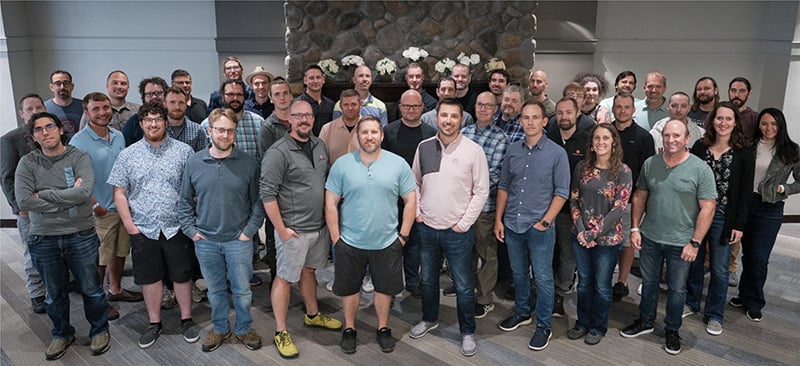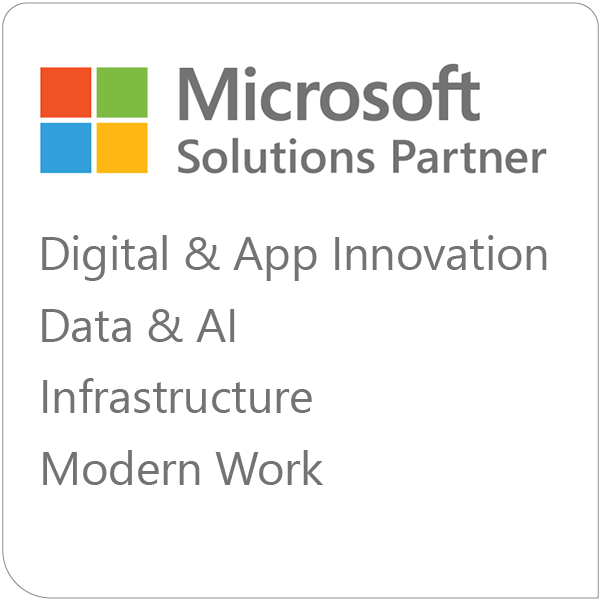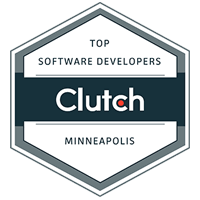In This Blog
- What Is Process Automation?
- Process Intelligence and Mining: Turning Data into Decisions
- From Task Efficiency to Strategic Transformation
- Agentic AI: Moving Toward Autonomous Work
- Microsoft Power Platform: A Strategic Automation Suite
- Key Architecture Components
- Inside Power Automate
- Copilot and Natural Language Automation
- Core Skills for Implementation
- Power Automate Roles Matrix
- Governance Best Practices
- Managing the Digital Workforce
- Licensing
- Key Recommendations
- Why Emergent Software
- FAQ
When implemented correctly, process automation becomes a powerful catalyst for business transformation. Future-focused businesses see automation as a strategic enabler of end-to-end process optimization, employee empowerment, and AI-driven innovation.
Organizations often begin this journey by identifying the manual workarounds that live in inboxes and spreadsheets. This might sound familiar: teams waste time manually entering data, reconciling files, or managing routine approvals. These patterns signal opportunity. The question becomes: can these processes be automated? And more importantly, how can they be standardized to ensure automation is sustainable and scalable?
What Is Process Automation?
Process automation is the use of software and technologies to automate business processes and functions in order to accomplish organizational goals. It targets repetitive, rule-based tasks that follow clear logic, freeing employees to focus on higher-value work.
Modern automation platforms combine workflow engines, robotic process automation (RPA) bots, integration connectors, and AI algorithms to execute processes consistently and at scale. Microsoft Power Automate is one of the most effective examples of this evolution, enabling intelligent workflows across your entire process ecosystem.
With hundreds of native connectors, ranging from Dynamics 365, Salesforce, and SAP to Dropbox, Snowflake or Oracle, Power Automate provides a bridge across siloed systems. Custom connectors add even more flexibility when prebuilt options don’t fit.

Process Intelligence and Mining: Turning Data into Decisions
The transformation doesn’t stop at automation. Process mining tools within Power Platform continuously monitor workflows, flagging issues, bottlenecks, and deviations as they emerge. This real-time insight empowers you to move from reactive fixes to proactive solutions.
Manufacturing Process Automation and Mining Use Case:
A large manufacturer uncovered $30-50 million in late payment penalties because the organization lacked visibility into payment terms embedded in supplier contracts. With process automation layered on top of process mining, they were able to connect incoming invoices to payment rules and execute payments more intelligently, preserving cash flow while avoiding penalties. This kind of transparency and responsiveness is a hallmark of intelligent automation.
AI enhances this capability further by supporting (not replacing) human judgment. When integrated thoughtfully, it fosters a culture of continuous improvement, encouraging experimentation, capturing frontline insights, and establishing feedback loops that drive better outcomes.
The business case is clear:
-
36% of enterprises now use predictive AI
-
35% are leveraging generative AI
-
77% cite process transparency as a key benefit of process mining
From Task Efficiency to Strategic Transformation
In the past, automation focused on isolated, department-level tasks. While useful, this limited the potential impact. Today, organizations are moving toward integrated, cross-functional automation that aligns with the entire customer journey.
This strategic shift delivers:
-
End-to-end process optimization
-
Integrated systems across silos
-
330% ROI potential in some scenarios
By combining automation with generative AI, organizations can process unstructured data, extend the life of legacy systems, and realize up to 5.4% annual revenue growth through redirecting resources towards growth-orientated activities.
Agentic AI: Moving Toward Autonomous Work
Artificial intelligence is evolving from assistive to autonomous. We’re entering an era of "agentic AI," where AI-powered agents function as digital colleagues, capable of making decisions, initiating workflows, and collaborating with human counterparts.
Rather than waiting for a predefined event, these agents can proactively assess context, like identifying a customer in the CRM who hasn’t been contacted in 30 days and launching a tailored email campaign. The agent can even manage the back-and-forth conversation until it's time for human intervention.
This marks a shift from reaction to orchestration, where AI isn’t just responding, it’s acting based on dynamic context.
-
Autonomous decision-making: Agents can act independently when confidence is high
-
Human-in-the-loop verification: Ensures oversight and compliance
-
Rapid Market Growth: 12.7% CAGR for standalone automation through 2028.
-
Future Integration: Gartner predicts 33% of enterprise software will include agentic AI by 2028

Microsoft Power Platform: A Strategic Automation Suite
The Power Platform brings together multiple tools that support low-code, high-impact development. Power Automate serves as the automation engine, but it's just one part of the broader ecosystem.
These are the four core components:
-
Power Apps: Rapid application development
-
Power BI: Business analytics
-
Copilot Agents: Chatbot development
-
Power Automate: for workflow and task automation
Together, these tools form a low-code platform that empowers both IT professionals and business users to innovate faster.
Key Architecture Components
Behind the Power Platform is an architecture built for scale and flexibility. A few foundational elements include:
-
Connectors that integrate with over 400 internal and external services, from Salesforce to SharePoint and SQL Server.
-
Dataverse, Microsoft’s secure data layer, which supports structured storage or virtualized data access.
-
Microsoft Entra ID (Azure AD) for identity, access management, and auditing across environments.
-
Governance controls like environment segmentation and DLP rules to maintain enterprise compliance.
This architecture makes it easier to modernize without migrating everything into a new data warehouse or suite. It allows organizations to bridge legacy and modern systems securely.
Inside Power Automate
Within Power Automate, several core components drive the powerful automation capabilities:
-
Cloud Flows that run in the cloud and are triggered by events, schedules, or user actions.
-
Desktop Flows (RPA) that simulate human clicks and keystrokes in legacy applications.
-
Connectors for easy data exchange.
-
AI Builder which includes pre-trained models for OCR, sentiment analysis, and prediction.

These components can be combined and configured to automate anything from routine ticketing to intelligent approvals.
Copilot and Natural Language Automation
Power Automate’s Copilot feature enables a natural language interface for building flows. Users simply describe the automation they want in plain English, and Copilot drafts the logic and wiring behind the scenes.
Rather than starting with a blank canvas, Copilot walks the user through connection setup, field mapping, and configuration in a guided way. This approach significantly reduces build time and opens automation to more users. No deep technical skills required.
Core Skills for Implementation
To scale intelligent automation, organizations need a mix of technical and business expertise. Key skill areas include:
-
Systems thinking and solution architecture
-
Business process analysis and reengineering
-
Data modeling and integration logic
-
Low-code development and UI configuration
-
Governance planning and security policy awareness
These skills support sustainable, scalable automation across teams.
Power Automate Roles Matrix
Effective automation requires cross-functional collaboration. One common challenge is the emergence of citizen developers who build useful flows, but without clearly defined process ownership or alignment with broader governance. To ensure consistency, it's important to define structured roles, encourage value stream mapping, and align everyone under a shared strategy.
Here’s a sample role matrix that outlines the key players needed to scale automation successfully:
|
Role |
Primary Skills |
Responsibilities |
|
Business Analysts / Owners |
Process design, requirements |
Identify opportunities, define goals |
|
Citizen Developers |
Low-code, domain expertise |
Build departmental solutions |
|
Power Platform Developers |
APIs, complex development |
Handle advanced use cases, mentor others |
|
Solution Architects |
Systems thinking, design patterns |
Design scalable, secure architectures |
|
IT Administrators |
Governance, platform management |
Enforce policies, manage environments |
Governance Best Practices
Scaling automation across the enterprise requires intentional governance to prevent fragmentation and ensure long-term success. As organizations adopt tools like Power Automate more broadly, it’s essential to lay the foundation for sustainable growth.
Three best practices we recommend implementing from the outset:
-
Establish a Center of Excellence (CoE): This centralized team defines standards, shares best practices, provides training, and monitors platform usage. Microsoft’s CoE Starter Kit can help jump-start this effort with tooling and templates.
-
Define an environment strategy: Segment development, test, and production environments to align with standard software development lifecycles. This separation ensures that flows are properly vetted before they go live.
-
Implement Data Loss Prevention (DLP) rules: DLP policies control which connectors can be used together, reducing the risk of sensitive data leaking across systems or external platforms.
When these controls are in place, organizations can scale automation efforts more confidently.
Managing the Digital Workforce
An automation lifecycle mirrors a traditional software development process but requires a shift in mindset to treat automation as part of the workforce. These digital flows, bots, and agents are doing real work and need to be managed accordingly.
The stages of an automation lifecycle include:
-
Ideation and intake: Business users and IT identify repetitive or rules-based tasks and assess their ROI potential.
-
Development: Teams design and build the automation using platforms like Power Automate, ideally with process owners involved to ensure accuracy and long-term usability.
-
Deployment: Flows are promoted to production, with ownership and maintenance plans clearly defined.
-
Monitoring: Usage, errors, and exceptions are tracked in real-time. Logs and alerts help teams troubleshoot and improve automation performance.
-
Maintenance: As systems or processes evolve, automation must evolve too. Without dedicated oversight, this step is often overlooked, leading to broken workflows and inefficiencies.

Treating automation like a digital employee means assigning responsibility, establishing visibility, and planning for its long-term success. Governance frameworks and collaboration between IT and the business are essential to keep your digital workforce aligned with your enterprise strategy.
Licensing
Power Automate offers flexible licensing based on user needs and deployment scale. Here are the different plan prices:
|
Plan |
Price |
Summary |
|
Basic (M365) |
$0/month |
Included in M365 subscriptions |
|
Per User Plan |
$15/month |
Unlimited cloud flows per user |
|
Per User with RPA |
$40/month |
Adds desktop automation |
|
Per Flow Pack (5 flows) |
$100/month |
Assign flows to any user |
|
Enterprise Process |
~$500/month |
Scalable flows with enterprise capabilities |
A $15/user/month license can be justified if it saves even 50 hours annually. Larger investments—like $500/month for high-volume workflows—can replace or significantly augment full-time roles.
Key Recommendations
To get the most from intelligent automation, we recommend the following:
-
Enable the business: empower non-technical teams with low-code tools.
-
Integrate and innovate: layer automation over legacy systems while modernizing in parallel.
-
Leverage intelligence safely: inject AI into processes with built-in security and governance capabilities, turning potential risks into strategic advantages.
-
Plan for governance: Invest in building the Center of Excellence, training both IT and citizen developers, and establishing clear governance early.
How We Can Help
At Emergent Software, we combine technical depth with practical business acumen:
-
Microsoft Experts: Certified across Azure, Power Platform, and automation
-
Business Process Enablement: We deliver measurable outcomes with automation
-
Proven Implementation Framework: Fast, secure, and scalable deployments
-
Continuous Partnership: Ongoing support, optimization, and training
We help clients move beyond theory, into real, repeatable automation success.
Let’s get started. Schedule a discovery session with us to explore how Microsoft’s Power Platform can help you modernize operations, empower your workforce, and unlock business value at scale.
This blog is inspired by a recent CIO Breakfast, a series hosted by Emergent Software for tech experts in the Twin City area. If you’re interested in attending our next event, please send us a DM on LinkedIn.
FAQ
1. What’s the difference between Copilot Studio and Power Automate?
Copilot Studio is focused on creating conversational AI agents that can interact with users in natural language. Think of it like a chatbot platform where you can build agents that reference dedicated knowledge repositories, HR policies, security guidelines, or benefits information, and respond intelligently to employee questions.
Power Automate, on the other hand, is built for orchestrating workflows—moving data, triggering events, and automating structured tasks. While Copilot Studio handles the conversation, Power Automate handles the action.
2. Do I need a separate Power Automate license to use it within Copilot Studio?
Not always. If users already have a Copilot license, the basic actions you kick off from Copilot Studio using Power Automate are included. However, more complex workflows or users without a Copilot license may be charged based on message volume.
Microsoft uses a consumption-based model where each “message” has a cost. Simple flows may consume one message, while complex flows might consume several, potentially costing up to 30 cents or more per run.
3. Where should my organization start with intelligent automation?
Start small and focus on a high-ROI use case, finance and HR are great starting points. Look for areas where employees are manually moving data between systems or monitoring inboxes, then map out the process using value stream mapping. Standardize where you can, then build.
4. How do I ensure automation doesn’t break as systems evolve?
Establish governance early. Automations are like digital employees—they need visibility, monitoring, and change management. Set up a Center of Excellence (CoE), define ownership for each flow, and separate dev, test, and production environments.
5. What’s the best way to scale automation across the business?
Build a cross-functional team with defined roles: business analysts to map processes, citizen developers to build flows, and IT to manage governance and security. Equip your solution architects to think beyond traditional integration and include automation as part of their toolkit.
Also, bring business users into the fold early, don’t wait until IT has everything perfect.






